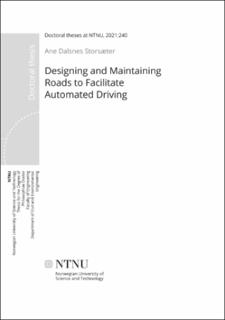| dc.contributor.advisor | Pitera, Kelly | |
| dc.contributor.advisor | McCormack, Edward | |
| dc.contributor.author | Storsæter, Ane Dalsnes | |
| dc.date.accessioned | 2021-08-10T07:26:46Z | |
| dc.date.available | 2021-08-10T07:26:46Z | |
| dc.date.issued | 2021 | |
| dc.identifier.isbn | 978-82-326-5241-9 | |
| dc.identifier.issn | 2703-8084 | |
| dc.identifier.uri | https://hdl.handle.net/11250/2767106 | |
| dc.description.abstract | Advanced Driver Assistance Systems (ADAS) are common in modern cars. ADAS features such as lane keeping and Adaptive Cruise Control (ACC) represent forms of lateral and longitudinal vehicle control, i.e., the basis for automated driving. The sensors and software on which such functionalities depend also determine some of their driving characteristics and abilities. Current road infrastructure has been designed for human drivers. With driving automation becoming commonplace and expected to take on a greater role in transportation, it is time that automated drivers are included as road users and considered in road design and maintenance standards. Automated drivers have, however, not been defined to the extent needed to make this possible. This thesis establishes a unified framework for including automated drivers as new road users and suggests starting points for adapting road design and maintenance to facilitate automated driving. Practical research from laboratory, test site, and real-life settings were performed using available data from ADAS applications for the latter. Based on these examples, suggestions for adaptions to design and maintenance to support automated drivers are presented. Furthermore, how ADAS functionality can be used to monitor the state of road assets is demonstrated.
1. The main findings of this thesis related to including the automated driver as a new road user are:
• Development of a new unified framework for automated and human driving that for the first time includes all driving processes and identifies characteristics of automated drivers based on existing technology.
• Characteristics of automated drivers found to be of special importance to transport engineering are:
– Increased electromagnetic sensitivity range.
– Greater field of view.
– Fundamental differences in cognitive processes.
2. The findings related to geometric road design for automated drivers are:
• Three parameters need to be redefined in the short-term for automated drivers: Eye height, Object height and Reaction time. New definitions of parameters could include replacing Eye height and Object height with new design parameters describing line of sight and object detection by automated drivers.
• A new manual for road design for transportation without human occupants is advised. The following geometric road design parameters can be revised with regards to automated freight transport: Vertical acceleration, Relative vertical speed, Minimum vertical curve radius (sag), Clothoid parameter, and Minimum horizontal curve radius (tunnels).
• The shapes and dynamic properties of vehicles should continue to be monitored for changes including Vehicle height, Vehicle width, Wheel distance, Overhang, Acceleration, Deceleration, and Reaction time.
3. The following findings relate to adaptions to road design for automated users:
• Colors, patterns, and textures can be used to make existing road infrastructure elements such as guardrails, dividers, and road markings gain higher visibility to facilitate automated detection.
• Visibility of traffic control devices in parts of the electromagnetic spectrum beyond the visible light can be used to add information for automated users, e.g., barcode layer in the near-UV for positioning.
• Contrast between road marking and road pavement is more important for camera-based lane detection than measures of retroreflectivity.
• Camera based Lane Departure Warning (LDW) systems appear to be independent of exterior lighting (other than headlights).
• Yellow road markings have higher visibility and contrast to the road surface and snow in color spaces HSL (Hue, Saturation, and Lightness), HSV(Hue, Saturation, and Value), and YUV (luminance, color component U and color component V).
• Yellow road markings can facilitate automated driving in snow better than white markings.
• The type and thickness of road marking may affect successful detection by camera based lane departure warning.
4. The following results of the thesis are related to road maintenance for human and automated users:
• Lane DepartureWarning functionality demonstrates that Advanced Driver Assistance Systems can be used to monitor the state of road markings.
• Lane Departure Warning functionality can be used to identify when conditions such as snow prevent detection of road marking.
• Data from Advanced Driver Assistance Systems can be used to define Operational Design Domains (ODDs) and Infrastructure Support Levels for Automated Driving (ISAD).
This research has established automated drivers as new road users and suggested starting points in processes to adapt road design and maintenance to facilitate automated driving. | en_US |
| dc.language.iso | eng | en_US |
| dc.publisher | NTNU | en_US |
| dc.relation.ispartofseries | Doctoral theses at NTNU;2021:240 | |
| dc.relation.haspart | Paper 1: Storsæter, Ane Dalsnes; Pitera, Kelly; McCormack, Edward. The automated driver as a new road user. Transport reviews 2021 https://doi.org/10.1080/01441647.2020.1861124 This is an Open Access article distributed under the terms of the Creative Commons Attribution-NonCommercial-NoDerivatives License (http://creativecommons.org/licenses/by-nc-nd/4.0/) (CC BY-NC-ND 4.0) | en_US |
| dc.relation.haspart | Paper 2: Storsæter, Ane Dalsnes; Pitera, Kelly; McCormack, Edward.D.
Preparing for Automated Drivers – An Evaluation of Current Road Design Parameters | en_US |
| dc.relation.haspart | Paper 3: Storsæter, Ane Dalsnes; Pitera, Kelly; McCormack, Edward. Using ADAS to Future-Proof Roads—Comparison of Fog Line Detection from an In-Vehicle Camera and Mobile Retroreflectometer. Sensors 2021 ;Volum 21.(5) https://doi.org/10.3390/s21051737 This is an open access article distributed under the Creative Commons Attribution License (CC BY 4.0) | en_US |
| dc.relation.haspart | Paper 4:
Storsæter, Ane Dalsnes; Pitera, Kelly; McCormack, Edward.D.
Camera-Based Lane Detection - Can Yellow Road Marking Facilitate Automated Driving in Snow? | en_US |
| dc.title | Designing and Maintaining Roads to Facilitate Automated Driving | en_US |
| dc.type | Doctoral thesis | en_US |
| dc.subject.nsi | VDP::Technology: 500::Environmental engineering: 610 | en_US |
